You and your buddy drift along what might be the most amazing dive site you’ve ever seen. The visibility is endless and the sealife is flourishing. Your ear to ear grins wane a bit as a dutiful glance towards your computer indicates that it’s time to head back to the ascent line. You signal "up" to your buddy as you approach your maximum allowable bottom time, and you begin your ascent together.
While you perform your safety stop, you and your buddy reflect upon the dive. Just as you begin to wish that you had had more time, you look down and notice two other divers still enjoying the scenery, and you wonder how it’s possible that they could safely stay so much longer than you….
Welcome to the wonderful world of Nitrox!
Primarily used to extend No Decompression Limits (NDL), Enriched Air Nitrox is known by many names: Enriched Air, EANx, or simply "Nitrox".
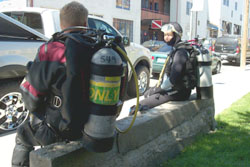
There are a few other benefits of Nitrox as well, and we will examine each of these in turn. Of course, because the universe is balanced, there are also disadvantages to its use, and these must be taken into consideration when deciding if it’s safe or appropriate.
To better understand what Nitrox is and how it works, we should first examine the air that we breathe.
As we all learned in our entry level scuba class, inert nitrogen is absorbed by our tissues under pressure, and this plays a role in determining our no decompression depth and time limits.
Air, and the compressed variety found in our scuba cylinders, contains approximately 21% oxygen. The bulk of the remaining gas is nitrogen, so for simplicity’s sake we’ll call that 79%.
If we replace some of that Nitrogen with oxygen, we shift those percentages, and can adjust our NDL.
For example, the NDL for 80ft/24m is 30 minutes according to the PADI tables. If we’re using EANx36 (pronounced "Enriched Air Nitrox 36", or simply "36%") there is only 64% nitrogen. The reduced nitrogen content is equivalent to air at a shallower depth, so when we are using EANx36 at 80ft, we’re absorbing the inert gas *as if* we were only diving to 59ft/18m, where the NDL is a significantly longer 55 minutes!
You’ll learn how to use Equivalent Air Depths and Tables in your basic Nitrox course, but many modern dive computers are "nitrox capable" and can calculate these adjusted limits for you when properly programmed.
Of course, 80ft is a significant depth, and while your NDL may be extended, you’ll still want to keep a watchful eye on your Submersible Pressure Gauge. You might find that your air consumption is now the limiting factor on certain dives.
Instead of extending the NDL, some divers choose to dive Nitrox using air tables/computers for added safety. In the above example, if the diver were using air and stayed for close to 30 minutes, he or she would be approaching the NDL. However, if the diver stayed for that same amount of time, but was using EANx36, he or she would be well within the adjusted 55 minute limit, thus reducing the potential nitrogen exposure.
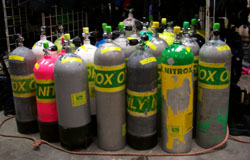
It’s important to note, however, that diving to the adjusted EANx limit is still diving to the limit, and is not inherently safer than diving air to its respective limit.
For many divers, another positive aspect of diving Nitrox is a reported reduction in fatigue. There is debate in the community about whether this is physiological or merely psychological, but you’ll find that most experienced nitrox divers swear by it. I, for one, am definitely less tired at the end of the day when diving Nitrox.
So, if Nitrox is so wonderful, why doesn’t everyone use it all the time? Well, as I mentioned earlier, there are drawbacks.
The most significant disadvantage to Nitrox is that there are depth limitations. Oxygen becomes toxic to our bodies at high partial pressure and over extended periods of use. A basic Nitrox course will teach you how to determine the Maximum Operating Depth (MOD) for a given blend and how to calculate cumulative oxygen exposure.
Basically speaking, the higher the oxygen content in a blend, the shallower our MOD becomes.
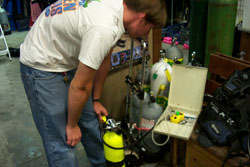
It’s imperative that each diver personally analyze the contents of any Nitrox cylinder with which he or she will be diving. This allows you to determine and avoid the MOD for the measured nitrox blend. You could be inviting tragedy if you thought you were diving a "lean" mix, when you were really using a "rich" one.
When analyzing your cylinders, remember to calibrate your analyzer to a known source (usually compressed air). It’s also best to calibrate using the same flow rate as when measuring the blend in question. Failing to calibrate properly, or using different flow rates, can yield inaccurate results.
Another disadvantage to Nitrox is that it requires dedicated and specially cleaned and maintained cylinders. Dedicated Nitrox cylinders are marked with specific labels to prevent confusion, and may only be filled with Nitrox (or air) from special oil free compressors.
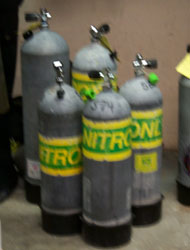
Nitrox is also not available in all areas. Special equipment and procedures are required to blend nitrox, and this is not feasible everywhere. The extra cost in producing and handling Enriched Air blends is reflected in the additional cost of renting Nitrox equipment and purchasing Nitrox fills.
Enriched Air can be created or blended in a variety of ways which would be explained in more detail in a Nitrox certification course, but generally, oxygen is either added to air, or nitrogen is removed from it.
Technically speaking, Nitrox is any mixture of Nitrogen and Oxygen, including blends with less than 21% O2, but for most diving applications, and in most areas, the term "Nitrox" is taken to mean a blend with 22% or greater concentration of oxygen.
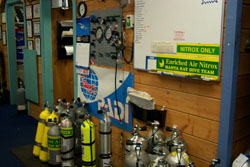
Despite the drawbacks and hazards mentioned, most people find that the benefits of Nitrox outweigh the risks. When proper safety precautions are followed, the risks are minimized, leaving a powerful stack of convincing arguments. If you’re already a Nitrox diver, you know what I’m talking about, and I’m preaching to the choir.
If you’re not yet certified, what are you waiting for? Ask your favorite Instructor about it and give it a try. You’ll be glad you did.
